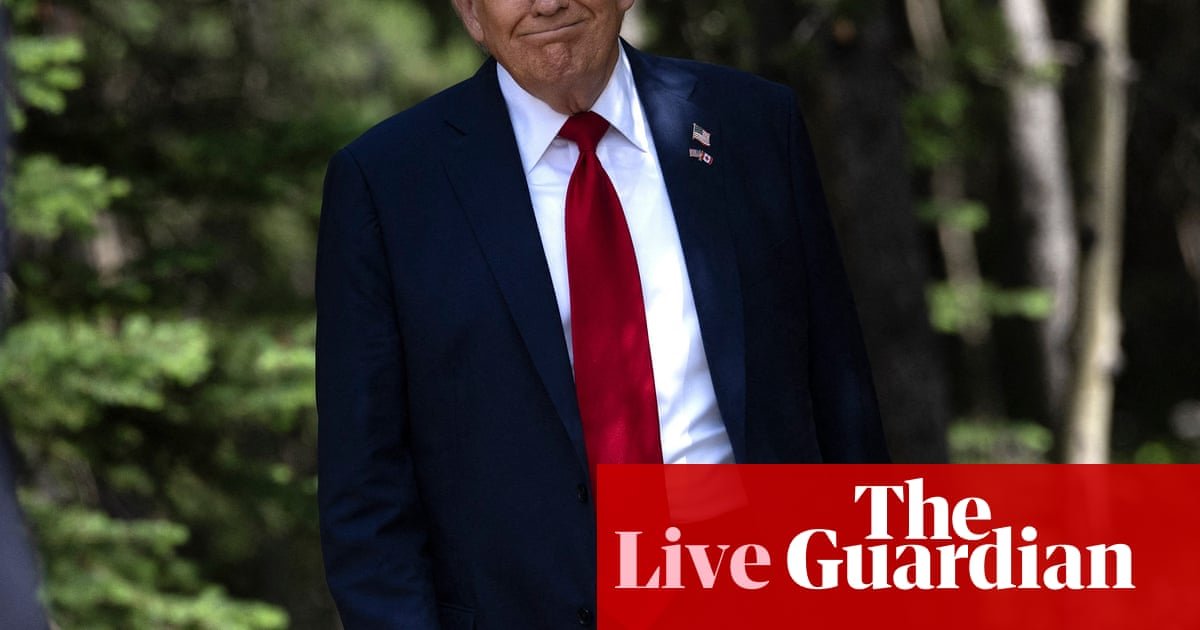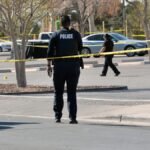Trump tariffs – explainer
As we still wait for Trump’s decision on tariffs, here’s a handy explainer to understand another week of Trump tariff turmoil.

Key events
As we still wait for Trump’s decision on tariffs, here’s a handy explainer to understand another week of Trump tariff turmoil.
Yad Vashem, Israel’s Holocaust memorial, condemned as a “desecration of historical truth” new plaques near a Polish monument to the wartime Jedwabne massacre of Jews by their Polish neighbours, AFP reported.
The plaques, crowdfunded and placed by the far-right on a private plot in vicinity of the official memorial just before of the 84th anniversary of the massacre, question the official findings and falsely claim that “the crime was committed by a German pacification unit” instead of local Poles.
Yad Vashem said it was “profoundly shocked” by “the descration of historical truth and memory.”
A Polish commission of inquiry concluded in 2003 that the 1941 massacre was perpetrated by Jedwabne’s Poles, urged on by the Nazi occupiers.
A spokesperson for the Polish ministry of foreign affairs also condemned the plaques.
Separately, Polish prosecutors also launched a preliminary investigation after a far-right lawmaker described the gas chambers at the Auschwitz death camp as a “fake,” AP reported.
Grzegorz Braun, a member of the European parliament, has previously been accused of antisemitism, and extinguished Hanukkah candles in parliament with a fire extinguisher in 2023. He was a presidential candidate who won more than 6% of the votes in the first round of the election earlier this year.
The director of the Auschwitz museum, Piotr Cywiński, said he would file a separate complaint with prosecutors. He said that “denying the fact that gas chambers existed is not only a manifestation of antisemitism and an ideology of hatred; in Poland it is also a crime.”
Poland’s prime minister Donald Tusk described Braun’s words as “a disgrace.”
Thousands of Bosnians gathered at a cemetery near Srebrenica on Friday to mark the 30th anniversary of a massacre, Reuters reported.
About 1,000 victims have yet to be found from Europe’s worst atrocity since the second world war, which still haunts Bosnia and Herzegovina’s 3 million people decades later.
At a ceremony on Friday, the partial remains of seven victims were to be buried alongside 6,750 already interred.
Survivors, families and dignitaries walked along rows of white gravestones. Some prayed and cried at the gravesides or sat motionless, heads buried in their hands.
“I feel such sadness and pain for all these people and youth,” said a woman called Sabaheta from the eastern town of Gorazde.
Alixandra Fazzina
Today, the landscape looks picturesque – but it holds memories of the largest mass killing since the second world war.
With approximately 10,000 people killed and systematic ethnic cleansing hollowing out almost the entire municipality, most former inhabitants have remained abroad as refugees, or live in other regions of Bosnia to which they were displaced.
Bosniaks (Bosnian Muslims), who made up three-quarters of the population before the war, are now the minority. Many of those who have come back feel unsafe, triggered by a pervasive climate of fear amid ever emboldened Slavic nationalism.
A photojournalist meets some of the Bosnian Muslim survivors building new lives alongside this legacy.
In May 1995, Julian Borger reported from Sarajevo during a week that was experiencing the heaviest bombardment for 18 months.
“The UN has given up all pretence of protecting the six Bosnian ‘safe areas’ it designated in 1993,” he wrote. Borger spoke to a shopkeeper washing blood from the pavement. “‘Fuck the UN’, was all he said.”
Nothing, it seemed, was able to avert the fate of Srebrenica. In July 1995, as Srebrenica was overrun, the 350 Dutch UN peacekeepers who had the impossible task of protecting the area were forced to capitulate, after promised airstrikes were abandoned.
Srebrenica finally fell on 13 July. Evidence that a massacre had taken place built swiftly, through accounts given by refugees and by the Dutch personnel who had been forced to abandon the UN post.
A story in the Observer by John Sweeney and Charlotte Eagar quoted a Dutch army captain: “The Muslim men were separated from their families and moved to a white building. I heard shots coming from the building.”
The full horror of Srebrenica emerged over the following weeks and months. Early in August, the New York correspondent Mark Tran reported that the US had presented the security council with “compelling evidence”, including aerial photographs of mass graves, that up to 2,400 Bosnian men were massacred after the fall of Srebrenica.
The UN report, immediately leaked to the Guardian, along with the testimony of Red Cross officials, made clear the probability that the number would be very much greater.
At the fall of Srebrenica, thousands fled into the surrounding country seeking to make their way to the safer ground of Tuzla, 162 miles away to the north-west, where a refugee camp had been set up.
On 14 July, Borger wrote:
“In tears and confusion, thousands of women, children and old men expelled from Srebrenica poured off buses yesterday at the decrepit air base in the town of Tuzla, northern Bosnia, accusing Serb rebels of murder and rape and the United Nations of indifference during the fall of the enclave.”
The front page of the Guardian on 15 July carried an image that became emblematic of the horrors of this European war.
Borger provided the words that went with it.
“In a crowd of over 10,000 refugees sprawled across Tuzla’s cornfields, a young woman hanged herself yesterday. No one knew her name. No one wept for her when her body was cut down from a tree, and only a single policeman kept vigil over her corpse as it lay abandoned by the gate of the heaving, sweating camp.”
She had been, Borger wrote, “one of the scatterlings of Europe, torn away more than once from friends, relatives and familiar places.”
A recently published Guardian history, Witness in a Time of Turmoil, added:
“The photograph by Darko Bandic, a Croatian photographer, breaking all the rules that in normal times would restrain its publication, was here allowed to provide at once an elegy and an indictment.
It was some time before her name, Ferida Osmanovic, became known.”
European Commission president Ursula von der Leyen has just issued a statement, marking the 30th anniversary of the Srebrenica massacre.
She said that it was one of the events in history that “cast a shadow that stretches across generations” and “stands among the darkest chapters in Europe’s collective history.”
It is our duty to remember and to preserve the truth, so that future generations know exactly what happened.
She pledged that “the European Union will never forget what happened in this town”.
“We acknowledge our past and recognise our responsibility for failing to prevent and stop the genocide. We will also never allow history to be rewritten.”
She pointedly said “we firmly reject and condemn any denial, distortion, or minimisation of the Srebrenica genocide, as well as the glorification of war criminals.”
“Political leaders have a great responsibility in that regard, in particular in Bosnia and Herzegovina and across the western Balkans.”
She ended by saying:
“I want to send a message to the people of Bosnia and Herzegovina: the European Union stands with you. We remain fully committed to supporting your country on its path toward EU membership.
Your political leaders should do their part so your country can find its place at the heart of our Union, where it belongs.”

Julian Borger
in Srebrenica
Three decades after genocide was committed in the middle of Europe, memories in the rest of world are beginning to fade, helped along by a relentless effort by the perpetrators and their allies to cover up evidence. But the sprawling murder scene in the hills and fields around Srebrenica continues to cough up its bones.
More than 8,000 men and boys (almost all Bosniaks – Bosnian Muslims) were killed here within a few days following 11 July 1995, when Bosnian Serb forces seized control of the area, supposedly a UN-protected haven.
Many thousands of Bosniaks had been murdered over the preceding three years of war in this part of the north-eastern corner of the country, but the scale and speed of the Srebrenica slaughter finally shocked the world into decisive action to end the conflict.
The illusion of UN protection crumbled when the Bosnian Serb army under Gen Ratko Mladić began an attack on the Srebrenica “safe area”. The Dutch UN battalion guarding the zone gave up its outposts in the face of the offensive, while many of the Muslim men of the area fled into the woods. The civilians left behind in the outlying villages fled to Srebrenica town and ultimately to the Dutch UN headquarters, a battery factory in a place called Potočari, farther north on the road to Bratunac.
The battery factory at Potočari is now the Srebrenica Memorial Centre, where artefacts have been placed in cavernous halls, next to the carcasses of socialist-era heavy machinery. Traces of the Dutch peacekeeper presence have been preserved including vicious graffiti about Bosnian girls left by soldiers who were supposed to protect them.
Occasionally, Dutch veterans revisit the site of one of the most shameful chapters in their country’s military history.
Bratunac and Srebrenica now lie within the boundary of a Bosnian Serb statelet, Republika Srpska, created by the Dayton peace agreement, which ended the war in November 1995. The Republika Srpska runs the local police and flies Serb flags across the region. Its leaders do not just deny the genocide, they glorify the killers.
The Srebrenica Memorial Centre stands like a small rocky island in a sea of denials, constantly buffeted by hostile waves. It was forced to close down in March after Dodik threatened to drive out Bosnian state authorities and force through secession.

Jakub Krupa
Today marks the 30th anniversary of Europe’s only acknowledged genocide since the second world war, the Srebrenica massacre.
Let us mark this with our reporting from Srebrenica and the region.

Jennifer Rankin
in Brussels
Elsewhere, the EU’s diplomatic service has drawn up a list of options to sanction Israel, after finding “indications” that the Middle Eastern country had breached its human rights obligations over its conduct in Gaza and the West Bank.
A document for EU foreign ministers to discuss next week outlines ten options, such as suspending the EU-Israel association agreement or visa-free-travel for Israelis, freezing preferential trade terms, or terminating Israel’s participation in Europe’s research and student exchange programmes.
The five-page text seen by the Guardian, first reported by Reuters, makes no recommendations.
It remains unclear if any of the proposals will gain traction. So far only one member state, Spain, has pushed for the suspension of the EU-Israel association agreement, which requires unanimity. Even governments that are Palestine’s strongest supporters in the EU are reluctant to back any move to reduce people-to-people contacts.
The paper emerged after EU foreign policy chief Kaja Kallas announced a potentially-significant deal with Israel to increase humanitarian aid to Gaza.
In a statement on Thursday Kallas said Israel had agreed to “the substantial increase of daily trucks for food and non-food items to enter Gaza”, as well as the reopening of the Jordanian and Syrian aid routes, distribution of food from bakers and public kitchens and resumption of water supply to the water desalination facility.
A spokesperson for Kallas said the agreement was the outcome of a dialogue Kallas launched with Israel’s foreign minister Gideon Sa’ar. Her pledge to raise the humanitarian crisis with Israel was made after the completion of the review of the EU-Israel agreement.
One open question is whether Kallas and EU member states now feel enough has been done to pressure Israel to change course, or whether more is needed. The EU response will certainly reflect how Israel implements the aid deal.
“We count on Israel to implement every measure agreed,” Kallas said.

Lisa O’Carroll
The EU and financial markets are on nervous standby to see if Donald Trump will carry through with his latest threat to hike import duties to 15% or 20%.
If he does it would signal a breach of good faith in negotiations which intensified in the past 10 days and almost certainly lead to calls for counter tariffs.
Trade ministers meet in Brussels on Monday and are expected to agree to extend its current 90 day pause on retaliation if a deal is announced today or over the weekend.
It has threatened 25% tariff on more than €20bn worth of US imports but paused them to create space for negotiations.
On Thursday night Trump ramped up his assault on Canada declaring he would impose a 35% tariff on imports next month and planned to impose blanket tariffs of 15% or 20% on most other trading partners adding the EU and Canada could receive tariff letters by Friday.
“Not everybody has to get a letter. You know that. We’re just setting our tariffs,” Trump told NBC News.
“We’re just going to say all of the remaining countries are going to pay, whether it’s 20% or 15%. We’ll work that out now.”
The declaration will have exasperated EU leaders who were already resigned to taking a 10% tariff as the price of doing trade with Trump, an import duty rate five times the average rate that applied before he was inaugurated in January.
EU diplomats said an agreement in principle is effectively on Trump’s desk waiting to be approved since Wednesday, his original self-imposed deadline for a deal.

Jakub Krupa
The EU could learn about Donald Trump’s proposal on tariffs today, after he said overnight a group of US trading partners, including the bloc, would get a letter “today or tomorrow”.
He said:
“I’m talking European Union, which is, as you know, many countries, and Canada. We’ll be putting them out over the next couple of hours.”
He later issued a letter to Canada, ramping up the proposed tariffs to 35%, up from the current 25%, and threatening to increase it further if Ottawa seeks to retaliate.
Not a great sign.
You can imagine lots of EU diplomats will be nervously refreshing Truth Social today.
It’s Friday, 11 July 2025, it’s Jakub Krupa here, and this is Europe Live.
Good morning.






